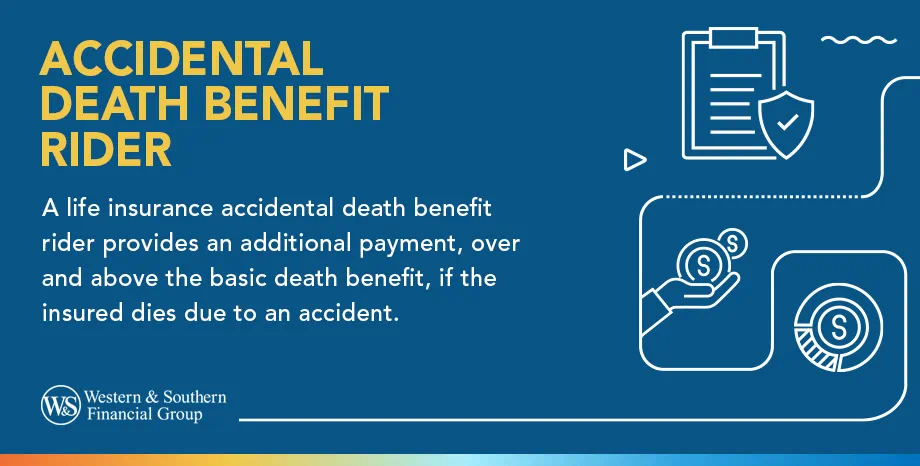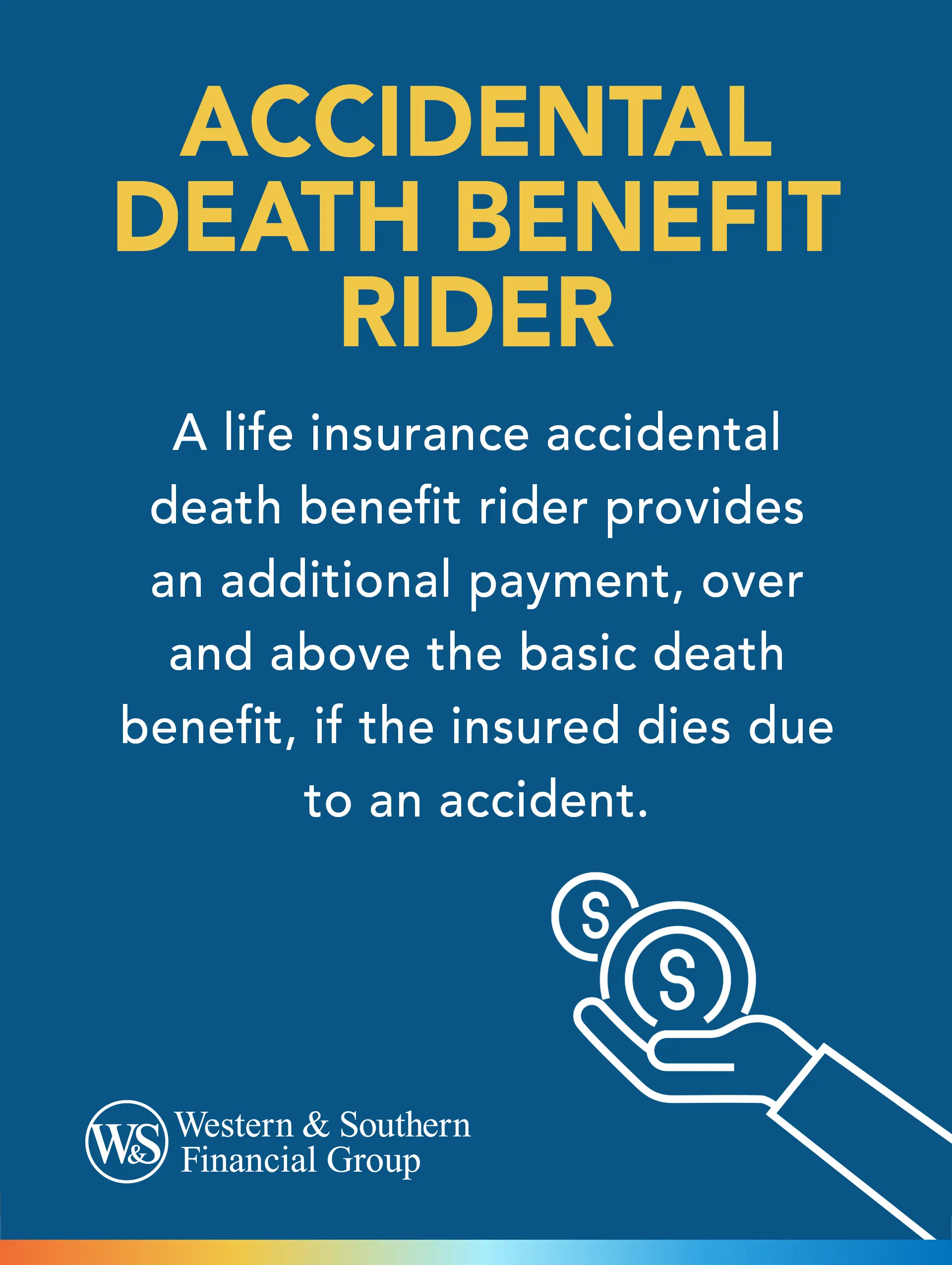

Table of Contents
- What Is an Accidental Death Benefit?
- How Does an Accidental Death Benefit Rider Work?
- What Does Accidental Death Benefit Cover?
- Who Is Eligible for an Accidental Death Benefit Rider?
- What Are the Benefits of an Accidental Death Benefit Rider?
- Potential Drawbacks of the Accidental Death Benefit Rider
- How Much Do Accidental Death Benefit Riders Cost?
- Is the Accidental Death Benefit Rider Right for You?
Key Takeaways
- An accidental death benefit rider is an optional life insurance add-on that provides an additional payout, typically double, if the insured dies accidentally.
- Accidental death benefit riders cover unforeseen fatalities, but "accident" definitions vary by policy, necessitating careful review.
- This rider's cost and eligibility vary by age, health, lifestyle, and coverage, and may increase over time.
- The accidental death benefit rider offers added financial security but can raise life insurance premiums significantly, so it needs careful evaluation.
- An accidental death benefit rider may be suitable if you face high risks at work, engage in dangerous activities, or have dependents.
What Is an Accidental Death Benefit?
An accidental death benefit rider (also known as accidental death rider) in life insurance is an add-on to a life insurance policy that provides an additional payment, over and above the basic death benefit, if the insured dies due to an accident. Receiving a payout for accidental death in addition to the base policy is commonly called "double indemnity."
What Is the Difference Between Death Benefit and Accidental Death Benefit?
A life insurance policy's death benefit provides a payout upon the policyholder's demise, regardless of cause. On the other hand, an accidental death benefit only kicks in if the insured's death is due to an accident.
If you have an accidental death benefit rider on your life insurance policy and you pass away from natural causes or illness, this additional coverage won't apply.
If your demise results from accidents such as car crashes or falls, then your beneficiaries could receive twice the face value of your policy. This is commonly called "double indemnity."
It's crucial that you understand these differences so you can make wise decisions about what type of coverage will best serve your loved ones' potential needs after you're gone.
Is an Accidental Death Benefit Taxable Income?
The answer is generally no. Accidental death benefits are not typically viewed as taxable income by the Internal Revenue Service (IRS)1. This means that if you're a beneficiary receiving this type of payout due to a loved one's unfortunate accident, it won't increase your annual income for taxation purposes. However, any interest earned on these sums can be subject to taxes.
As with all financial matters, it's wise to consult with a tax advisor or financial advisor who can give personalized advice based on your specific circumstances.
Is There a Difference Between Accidental Death Benefit (ADB) and Accidental Death and Dismemberment Insurance (AD&D)?
Accidental Death Benefit is an optional rider on a life insurance policy, providing an additional payout if you die due to an accident. It's like adding a safety net to your existing life insurance.
Accidental Death and Dismemberment Insurance is a standalone policy that not only covers accidental death but also pays out for severe injuries or dismemberment resulting from accidents. This can include losing sight, hearing, or limb functionality.
So while both help protect you and your loved ones from unexpected events, AD&D offers broader coverage.
How Does an Accidental Death Benefit Rider Work?
If your death occurs due to a covered accident, as defined by the terms of your policy, the beneficiaries would receive the policy's standard life insurance death benefit and the additional amount from the accidental death benefit rider.
The conditions for what qualifies as an "accidental death" can vary from policy to policy, so it's essential to thoroughly read and understand the terms and conditions before adding any rider to a life insurance policy. Some policies may exclude certain types of accidents or risky activities.
It's important to note that the specifics of a life insurance policy's death benefit and other life insurance riders can vary depending on the insurance company and the specific policy terms and conditions. Always review the policy's details and consult with an insurance professional to fully understand the benefits, limitations, and costs.What Does Accidental Death Benefit Cover?
An accidental death benefit provides additional coverage for unexpected, non-health related fatalities. It's important to understand that "accident" here is defined very specifically by insurance companies. It generally refers to any injuries caused by an unforeseen event, independent of illness or natural causes, resulting in fatal injury. Examples of accidents may include car crashes, falls, or other sudden and unexpected incidents.
It's also important to note that an accidental death benefit rider comes with exclusions. It usually does not cover deaths resulting from medical procedures, suicide, drug overdose, war, illegal activities, or death occurring when participating in risky activities such as skydiving or car racing. Additionally, insurers often limit the payout for accidental death riders to a certain age, typically 70.
It's advisable to read the terms carefully and discuss them with a knowledgeable insurance professional to ensure you understand the coverage, including the benefit amount and what is considered accidental death.
Who Is Eligible for an Accidental Death Benefit Rider?
Generally, anyone who has a current life insurance coverage can add an accidental death benefit rider to their existing life insurance policy. However, your eligibility could be influenced by your age, health status, and the specifics of your job or lifestyle. Most insurers have age limits for this rider - usually between 18 and 70 years old.
Keep in mind that the main purpose of this life insurance rider is to provide additional financial security to your beneficiary if you were to suffer an accident resulting in death. Therefore, it's crucial to assess whether the added cost aligns with the potential benefits based on your unique circumstances before deciding to augment your coverage with an accidental death benefit rider.
What Are the Benefits of an Accidental Death Benefit Rider?
The accidental death benefit rider, one of the many life insurance riders available, is designed to provide additional insurance coverage in case of unexpected accidents. The main benefit is the financial protection it offers to your loved ones. Over 42,000 people died in motor vehicle crashes in 2022.2
Should an accident claim your life unexpectedly, the policyholder's beneficiaries receive a significant payout above and beyond the standard death benefits of their life insurance policy. This additional financial support can be vital in helping them navigate through challenging times and helps provides you peace of mind knowing that your family will be well-cared for financially should tragedy strike.
Potential Drawbacks of the Accidental Death Benefit Rider
Despite the additional benefit it offers, you might find that this added insurance feature isn't without potential drawbacks. The accidental death benefit rider on your life insurance policy could significantly increase your premium payments. As such, it's essential to consider if the additional risk coverage is worth the extra cost.
Obtaining a double indemnity claim can be complex and entail stringent conditions outlined in your insurance company contract. For instance, death must occur within a specific timeframe after an accident and only from injuries directly related to that accident.
How Much Do Accidental Death Benefit Riders Cost?
The cost of an accidental death benefit rider varies based on factors that are part and parcel of insurance underwriting. This includes your age, health status, lifestyle choices, and the amount of coverage you desire for end-of-life costs. For permanent life insurance policies, the costs may be higher due to their lifelong coverage period.
Remember that while these additional premiums might seem small initially, they can add up over time. But considering the potential payouts if an accident occurs, many consider it a valuable addition to their policy. It's all about weighing your needs and risks appropriately.
Is the Accidental Death Benefit Rider Right for You?
This decision largely depends on your individual circumstances and risk tolerance. If you work in hazardous conditions or regularly engage in high-risk activities, this rider could provide invaluable serenity.
It's also worth considering if you have dependents who rely on your income—this extra coverage could secure their financial future should the unexpected happen.
Keep in mind that there are various types of life insurance policies and optional riders that may be suitable for your needs. It is important to take the time to thoroughly research and consider all available options, taking into account your financial objectives and personal preferences.
As with all financial decisions, discussing your options with a financial advisor or insurance professional is recommended. They can help you evaluate the costs and benefits of financial protection based on your specific needs and goals
Sources
- Life Insurance & Disability Insurance Proceeds https://www.irs.gov/faqs/interest-dividends-other-types-of-income/life-insurance-disability-insurance-proceeds
- NHTSA Estimates for 2022 Show Roadway Fatalities Remain Flat After Two Years of Dramatic Increases. https://www.nhtsa.gov/press-releases/traffic-crash-death-estimates-2022.













